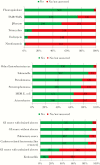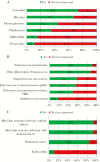Practice Patterns of Infectious Diseases Physicians in Transitioning From Intravenous to Oral Therapy in Patients With Bacteremia
- PMID: 33335941
- PMCID: PMC7731529
- DOI: 10.1093/ofid/ofz386
Practice Patterns of Infectious Diseases Physicians in Transitioning From Intravenous to Oral Therapy in Patients With Bacteremia
Abstract
Background: Bacteremia in adult patients has traditionally been treated with extended courses of intravenous antibiotics. Data on the use of (or rapid transition to) oral therapy are limited.
Methods: Adult infectious disease physicians participating in the Infectious Diseases Society of America Emerging Infections Network (EIN) were surveyed regarding their use of oral antibiotics in patients with bacteremia. Respondents were asked to assume that patients were hemodynamically stable, recovered bacteria were susceptible to potential antibiotics, adequate source control had been achieved, and patients had adequate gastrointestinal absorption. Variables of specific bacteria, oral agent, and associated infection were included.
Results: A total of 655 (50%) of 1321 EIN participants responded. Under certain conditions, 88% would transition patients with Gram-negative bacteremia to complete a course of therapy with oral antibiotics; 71% would transition patients with Gram-positive bacteremia to oral agents. Only 78 (12%) respondents would not treat any bacteremic patient with oral agents. Most respondents (≥75%) were comfortable treating infections secondary to Enterobacteriaceae, Salmonella, Pseudomonas, Stenotrophomonas, Streptococcus pneumoniae, and β-hemolytic streptococci with oral agents. Fewer than 20% endorsed use of oral antibiotics for Staphylococcus aureus or in cases of endocarditis. Fluoroquinolones and trimethoprim-sulfamethoxazole were the preferred agents in Gram-negative bacteremia; linezolid and β-lactams were the preferred agents in Gram-positive bacteremia.
Conclusions: In select circumstances, the majority of respondents would transition patients to oral antibiotics, in both Gram-negative and Gram-positive bacteremia. Most agreed with the use of oral agents in Gram-negative bacteremia caused by Enterobacteriaceae, but they would not use oral agents for Gram-positive bacteremia caused by S aureus or in endocarditis.
Keywords: bacteremia; oral antibiotics; oral antimicrobial agents.
© The Author(s) 2019. Published by Oxford University Press on behalf of Infectious Diseases Society of America.
Figures


References
-
- Mercuro NJ, Stogsdill P, Wungwattana M. Retrospective analysis comparing oral stepdown therapy for enterobacteriaceae bloodstream infections: fluoroquinolones versus β-lactams. Int J Antimicrob Agents 2018; 51:687–92. - PubMed
-
- Kutob LF, Justo JA, Bookstaver PB, et al. Effectiveness of oral antibiotics for definitive therapy of Gram-negative bloodstream infections. Int J Antimicrob Agents 2016; 48:498–503. - PubMed

